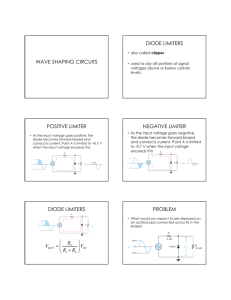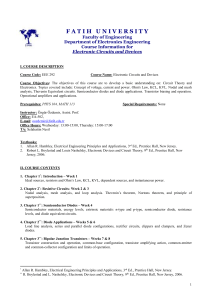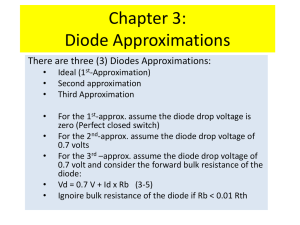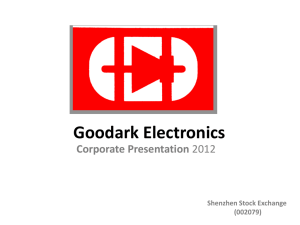chapter 2.1
advertisement
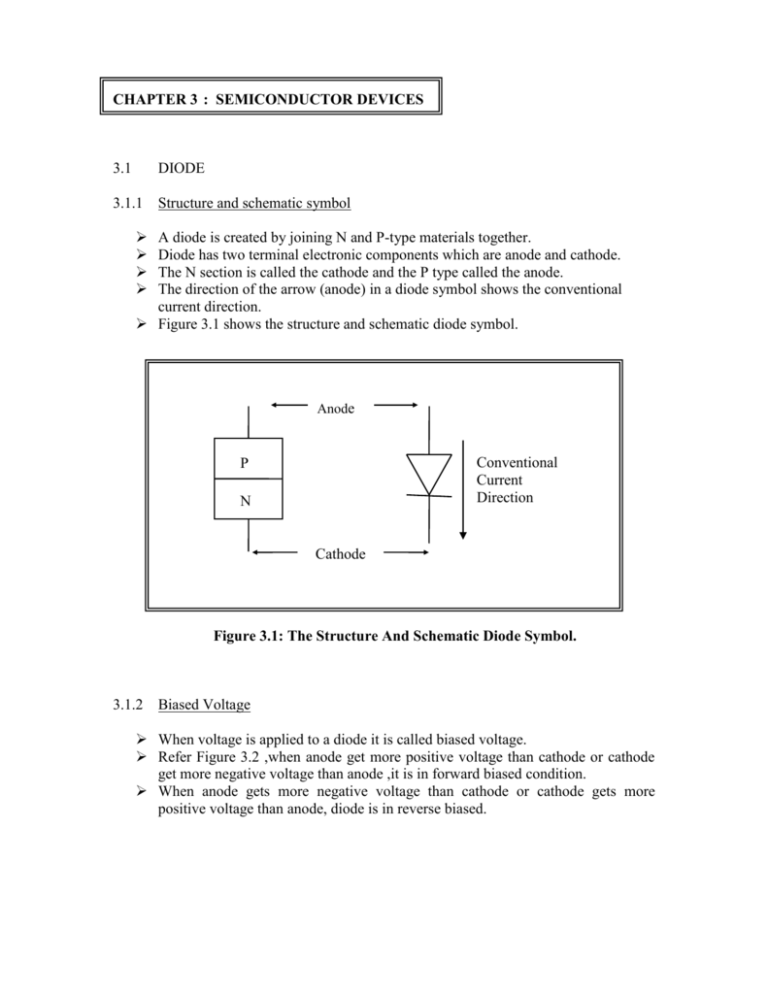
CHAPTER 3 : SEMICONDUCTOR DEVICES 3.1 DIODE 3.1.1 Structure and schematic symbol A diode is created by joining N and P-type materials together. Diode has two terminal electronic components which are anode and cathode. The N section is called the cathode and the P type called the anode. The direction of the arrow (anode) in a diode symbol shows the conventional current direction. Figure 3.1 shows the structure and schematic diode symbol. Anode Conventional Current Direction P N Cathode Figure 3.1: The Structure And Schematic Diode Symbol. 3.1.2 Biased Voltage When voltage is applied to a diode it is called biased voltage. Refer Figure 3.2 ,when anode get more positive voltage than cathode or cathode get more negative voltage than anode ,it is in forward biased condition. When anode gets more negative voltage than cathode or cathode gets more positive voltage than anode, diode is in reverse biased. A C + A Diode connected with forward biased C + Diode connected with reverse biased Figure 3.2 :Schematic Diode Circuit 3.1.3 I-V Characteristics For Diode. Id (mA) Breakdown Voltage Vs Vd Barrier voltage Is (A) Figure 3.3 : I-V Characteristics Curve For Diode Forward Current(Id) - Current flow through diode when forward biased . In unit mA (miliampere). Reverse Current(Is) The lowest current ,leakage current flow through diode when reverse biased . In unit μA(microampere). - Knee Voltage - Voltage level where the forward current increases. Knee Voltage = Barrier Voltage (Si=0.7V , Ge=0.3V) Breakdown Voltage - The applied reverse voltage at which the breakdown occurs. A large increase in current will damages the P-N junction diode. 3.1.4 Ideal Diode Concept While diode operated, diode characteristics will make analyze process for electronic circuits become difficulty. The characteristics are :i. ii. iii. Barrier voltage Forward Current Reverse Current(Leakage Current) In ideal diode concept, we assume diode did not have barrier voltage, no leakage current, no forward resistance (rd) and no breakdown voltage. Figure 3.4 shows diode curve characteristics become ideal when certain part have been neglected. Id Id Vd Normal Vd rd (neglected) Vs Vd voltage barrier (neglected) Vs Is Normal Id Vs Is leakage current (Neglected) Is Breakdown voltage (Neglected) Figure 3.4: I-V Characteristics When Idealized Diode In ideal diode concept, while forward biased, diode acts as close switch (ON) because no resistance and also no voltage drop. While reverse biased, diode act as open switch which is infinity resistance and no leakage current. Anode Cathode Close switch Forward biased diode Anode Cathode Open switch Reverse biased diode Figure 3.5: Ideal Diode When Forward Biased And Reverse Biased 3.2 Zener Diode Zener diode is important in power supply. It can be used to stabilize or regulated voltage. The symbol for Zener diode is shown in Figure 3.6 Cathode Anode Figure 3.6 : Zener diode schematic symbol 3.2.1 Characteristic curve for Zener diode Figure 3.7 shows the I-V characteristic curve for Zener diode. Id Breakdown voltage = Zener voltage Vz Vd Vs Is Figure 3.7 : Diode Zener characteristic curve While forward biased, characteristic curve has no different than normal value While reversed biased, diode current increase drastically at Breakdown level are sharper. The different between Zener diode and normal diode are Zener diode operate when reversed biased. While forward biased, Zener diode operates as normal diode. There are advantages for diode: i. ii. Zener diode is designed to work in reverse bias direction without harming the diode. At zener level, reverse voltage across diode ,VR remain constant and the value is same with zener voltage. 3.2.2 Ideal Zener diode concept While Zener diode operation in the Zener region, voltage across diode are same as Zener voltage (Vd = Vz ). Any changes in the voltage will change the current value through it. Therefore, Zener diode is assumed as battery with Vz value. (Figure 3.8) Anode Cathode - + Figure: 3.8 3.3 LED A light emitting diode (LED) is a special semiconductor diode designed specifically to emit light when current flow through it. Normally it is used as an indicator lamp either in ‘ON’ or ‘OFF’ condition. Figure 3.10 shows the schematic symbols for LED. LED and diode symbols are similar. The arrow direction that’s come out from P-N shows lights come out from LED. Cathod e Anode Figure 3.10 : Schematic symbol for LED Same as diode, LED operation is when forward biased. Electron from Ntype material will combine with hole from P-type material. If the semiconductors are Si and Ge, the result of the recombination is heat. When forward biased, the energy of the electrons flowing through the resistance of the junction is converted directly to light energy. Because LED is diode, current will flow only when the LED is connected in forward biased. The LED must be operated within its specified voltage and current ratings to prevent irreversible damage. Most LED require approximately 1.5 to 2.2V to forward biased them and safely handle 20 to 30 mA of current. Conventional Silicon / Germanium convert energy to heat. Gallium arsenide diodes convert energy to heat and infrared light. This type of diode is called an infrared emitting diode (IRED). Light emitting diode are used alphabetical and digital displays and as signaling lamps. 3.4 Bipolar Junction Transistor (BJT) Like diode, BJTs are formed by P and N region and as we are already the point at which P and N region join is known as a junction. The bipolar junction transistor is a three terminal current operated semiconductor device. The terminals are called the emitter, base and collector. The emitter and collector is made up of the same type of semiconductor material. Figure 3.11 shows the structure and schematic symbol for NPN and PNP transistor: COLLECTOR N P B ASE N EMITTER STRUCTURE SYMBOL COLLECTOR P N BASE P EMITTER STRUCTURE SYMBOL The arrow at the transistor symbol shows the direction of conventional current when it is operates. Either NPN or PNP, the base is very thin .Contains less majority current carrier. Emitter functions as charge provider or majority current carrier in transistor. Collector has to collect charge for circuit operates. Base is the junction which is control the current flow. 3.4.1 Biased Voltage Biased voltage applied to transistor to operate successfully. There are two type of biased voltage supplied to the transistor as a signal for it operations. Refer to the figure 3.12 the two main condition in biasing a transistor are: i. E-B(emitter-base) junction must be forward biased ii. C-B (Collector –base )junction must be reverse biased E E C N P C P N B N P B Figure 3.12 : Biased Voltage For Transistor 3.4.2 Transistor Operation E N P - - - - - - - - - - + + + N - - - - - - - - - - C B V1 V2 Figure 3.13: Electron Current Flow By referring Figure 3.13, since E-B junction has been forward biased by V1, E-B junction will flow the current because of electrons at emitter (N-type) will move by negative potential supply V1. These electrons tried to go to positive potential V1 through base (P-type). But because of base only a thin layer and have small amount of hole, not all electrons can flows. Only little electrons current can flow at the base known as base current, IB. The others electrons will collect at base layer in large amount. Because of collector layer has been connected to positive terminal of V2, the positive potential will attracted that electrons flow through collector as current collector, IC. IC IE IB Figure 3.14 : The electrons flow in transistor Arrow in Figure 3.14 above shows the flows of electrons in transistor. Showed that IC is the largest portion from IE and smallest portion flows as IB. From this we can obtain: IE = IC + IB




